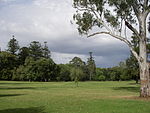Lot Fourteen is a development site in the Australian state of South Australia which accommodated the old Royal Adelaide Hospital (RAH) at the eastern end of North Terrace, Adelaide and which became vacant after the hospital function was moved to a new building at the western end of North Terrace in 2017. Its name was derived from the original 1837 plan for Adelaide by surveyor-general Colonel William Light. By 2020, refurbished hospital buildings were home to a large number of tenants, and further new buildings and public spaces are planned, scheduled for completion around 2025. Some non-heritage buildings were demolished. The redevelopment of the site is led by the Department of the Premier and Cabinet, headed by state premier Steven Marshall since late 2018.
The 7 ha (17-acre) site is in within the cultural precinct of the city, next to the Adelaide Botanic Garden and with the University of Adelaide, University of South Australia, Adelaide Botanic High School and the Art Gallery of South Australia as close neighbours. The urban planning arm of the South Australian government, Renewal SA, is responsible for the redevelopment of the site. A mixed development, incorporating cultural institutions as well as residential, hotel and office uses is planned. Federal funds have been injected into the project, under an agreement known as the "Adelaide City Deal".
The Aboriginal Art and Cultures Centre (AACC), also known as Tarrkarri, a new Aboriginal cultural centre and gallery planned for completion in 2024/5, will be the centrepiece of the development. This will exhibit a large number of cultural artefacts currently in storage in the South Australian Museum as well as artefacts and works of art sourced elsewhere.
An entrepreneurial hub known as FIXE@LotFourteen (Future Industries Exchange for Entrepreneurship at Lot Fourteen) is being developed. A new 16-storey building will house the Entrepreneurial and Innovation Centre.
The headquarters of the Australian Space Agency, a Commonwealth government department, are located in the McEwin Building, along with SmartSat CRC and other space-related companies. The Australian Cyber Collaboration Centre (A3C) is housed in the Eleanor Harrald Building (former nurses' quarters), along with other technology businesses such as Inovor Technologies (space technology) and Presagen (health technology).
The Australian Institute for Machine Learning (AIML), an artificial intelligence research institute created collaboratively by the state government and the University of Adelaide, is located in the south-western corner of the precinct.
The Stone & Chalk start-up hub, in the old Allied Health Building, houses the MIT's bigdata Living Lab, along with 45 technology-focused enterprises.
An International Centre for Food, Hospitality and Tourism Studies is also being planned for the site.








